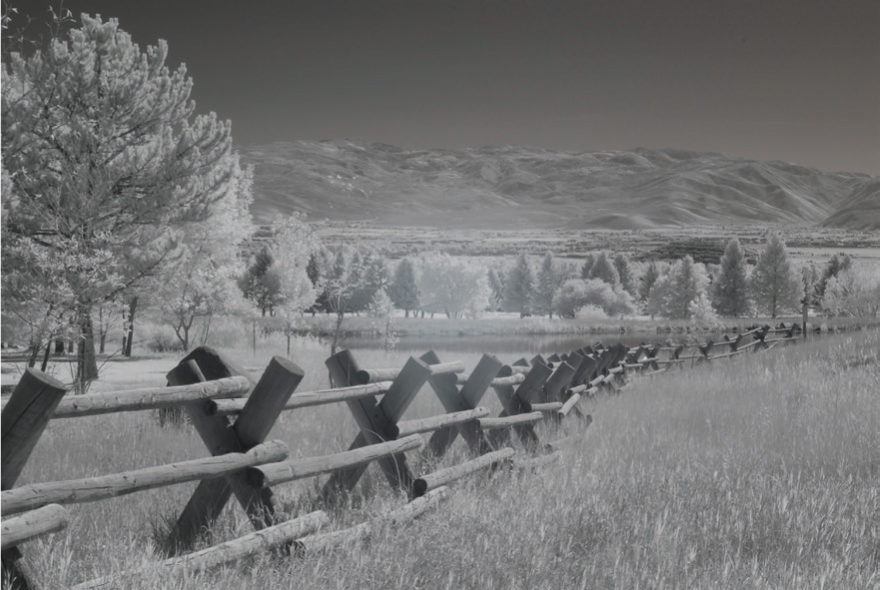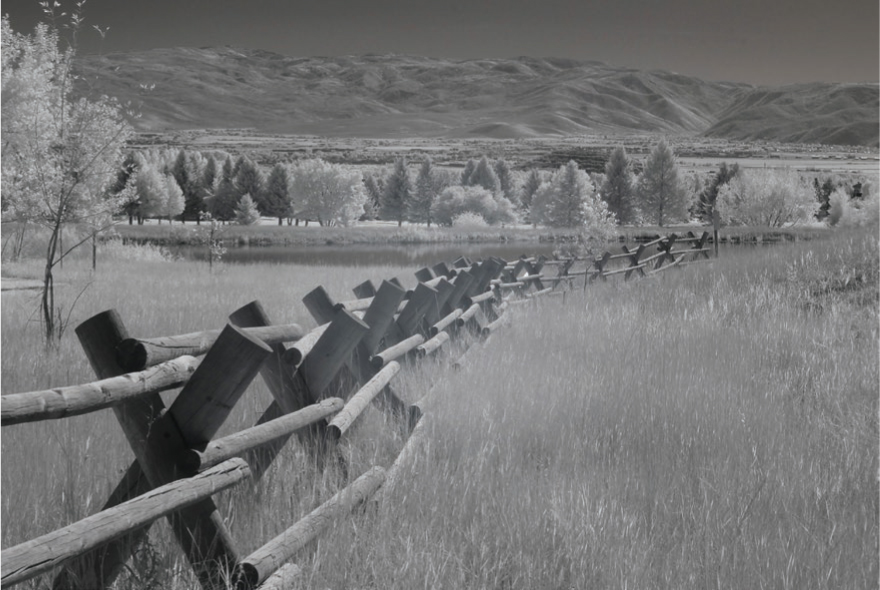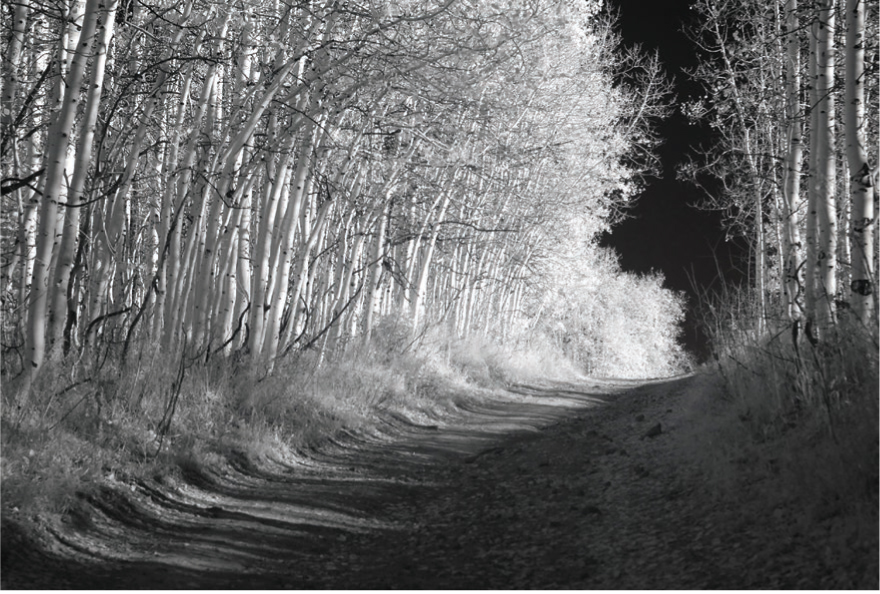Lenses Behaving Badly with Infrared
Photographers expect high-end lenses to produce the best photographic results. When it comes to lens selection for infrared photography, though, that rule may go out the window. Many high-end lenses have a coating that can cause a hot spot in the center of an infrared image. Also, when it comes to infrared capture, certain lenses are extremely susceptible to flare. Hot spots and flare are difficult—if not impossible—to eradicate in postproduction.
“Hot spots and flare are difficult—if not impossible—to eradicate in postproduction.”
Research how a specific lens—whether cheap or expensive—will function with infrared before investing in it. The Internet is sprinkled with advice from shooters who have had experience with how infrared interacts with given lenses.
But Wait!
Inexpensive “kit lenses” (those that come with a new camera as a package deal) can work well with infrared-converted cameras. Pick them up on the Internet—with or without the camera—for pocket change.
Professional photographers who are skilled in capturing light in the visible spectrum know what to expect from their lenses. Some may be sharper than others, and some may have anomalies around the peripherals. Beyond that, the results don’t come as much of a surprise. Unfortunately, when it comes to infrared photography, some lenses perform better than others, and a few should not be used at all.
It would be useful to include a list of lenses and their performance with infrared in this book, but such a tabulation would become a litany of “ifs” and “buts.” Some primes are good; some are not. Some telephotos perform better than others. It is said that macros and wide angle lenses may not focus well in infrared. Troll the Internet for information on any lens you consider using. Also, be sure to test all of your lenses with your infrared camera and retire the ones that are soft or have an otherwise undesirable performance. Most of the time, it’s not you making the focus error, it’s the lens.
Focusing Issues
Once upon a time, lens manufacturers inscribed lens barrels with settings that allowed photographers to ensure that infrared wavelengths were correctly focused. With today’s digital cameras, this is no longer the case.
Infrared wavelengths are longer than visible light wavelengths; therefore, the focus will be different when shooting infrared. Your camera conversion company should calibrate for the disparity. Once calibrated correctly, the internal infrared filter should work for all the lenses used with that camera. Nevertheless, it’s a good idea to share your go-to lens information with the conversion company just to be certain everyone is on the same page.
Hot Spots
Hot spots—bright areas in the middle of the frame—can appear in your image when the coating on the lens barrel reflects infrared light, when there is light interaction between the coating on the lens elements, or when there is light interaction between the lens elements and the image sensor (usually with micro lenses). When coated screw-on lens filters are used on a camera that has been converted to capture the full-spectrum of infrared wavelengths, hot spots may also appear.
To take hot spots out of your imaging equation, test each lens you will be using. Capture a test image at every available f-stop. Hot spots (and also soft images) can result when narrow apertures are used. It may be best to avoid working with narrow apertures unless you have done your due diligence to test the lens you plan to use and know that narrow apertures will pose no problems.
Wide Angle Distortion
If the lens you intend to use for your infrared photography tends to distort when capturing visible light images, chances are, the distortion will be even more pronounced in infrared due to the longer wavelengths.
Soft Images
Infrared images are often—but not always—soft. Softness can be caused by use of a narrow aperture when shooting, the interaction of a certain lens with infrared wavelengths, or inadequate light. Softness may also be due to incorrect calibration during the conversion process or lack of contrast. (Postproduction contrast enhancement is discussed in chapter 9.)
Take a look at the images I created during my attempt to photograph a bride and groom with a starburst effect in the background (see page 45). My first experiment with starbursts in infrared failed terribly, mainly because of the narrow aperture required for sunbursts.
Always test a lens before packing it for an important photo shoot. Hot spots and lens flare may be hard to detect in the field. Don’t allow these issues to come as a devastating surprise during post-processing. Don’t trust past regular DSLR experience in determining at which angle you might get a flare. Infrared is devious. Sometimes experience counts for success; at other times, it’s the luck of the draw.

Not all infrared images are soft. Alex Morgan pulled off a very successful image while shooting into the sun.
October 19, 2010, Midway, Utah
With excitement, I attached my new Nikkor 50mm f/1.4 prime lens to my newly infrared-converted Nikon D200 and skipped off into the woods. Setting out along a remote forest road in Utah’s Uinta range, I was confident that I would find the perfect setting for infrared photography. Gorgeous ponds with mirrorlike sheen, stately birch trees, and old wooden fences gave me optimism that I had found the required fodder that would make for great infrared images.
As I shot, I occasionally checked the LCD panel. Bright sunlight made it difficult to gauge the captures accurately, but I could definitely see the characteristic white foliage and rich, dark skies. I gushed with excitement—I was actually shooting infrared! A few more checks caused me to wonder about a white area in the middle of the image. “The bright sun is preventing me from getting a correct view of the LCD panel,” I rationalized. Click. Click. Click. Click. Click.
When I began processing those images, there was definitely a hot spot directly in the middle of the grayish images. Not wanting to think I had made a big mistake by getting my camera converted instead of getting a few bucks by selling it, I called Clarence at Spencer’s Camera & Photo (where I got the camera converted) to see if he would own up to any possible mistake in conversion (it’s never operator error, of course) or to find out whether this was the way infrared performed and I would have to live with it. Fortunately, some images were captured with a wider aperture; the hot spot was fainter in those shots. Strange. My 16mm lens did not show any hot spots at all.
In presenting my quandary to Clarence, without hesitation, he assured me not to worry and inquired as to what kind of lens I was using. My new 50mm lens was actually the culprit.

Nikon D200, 50mm lens. Two factors caused this hot spot: a coated lens of recent manufacture and a narrow aperture of f/16.

Here, the same 50mm lens was used, but I chose a wider aperture of f/10. Shooting at a wider aperture helped to decrease the hot spot.

This image was shot on the same day. I used an aperture of f/4 (not the best for landscape photography) with the 50mm lens. There is hardly any sign of a hot spot.